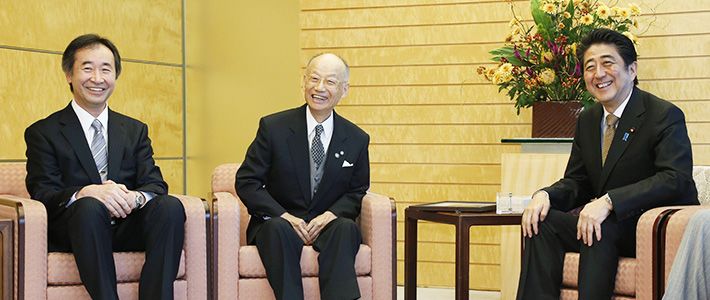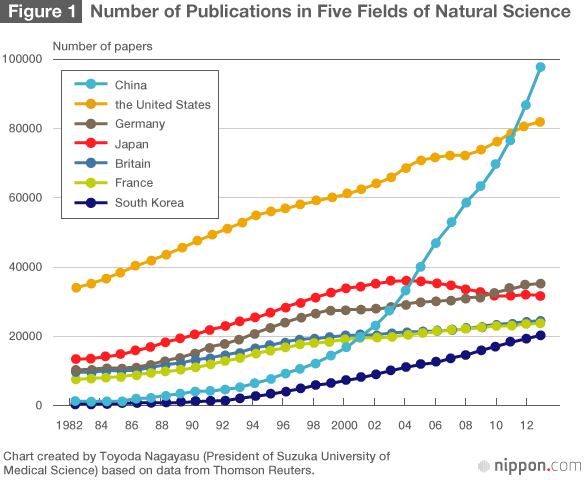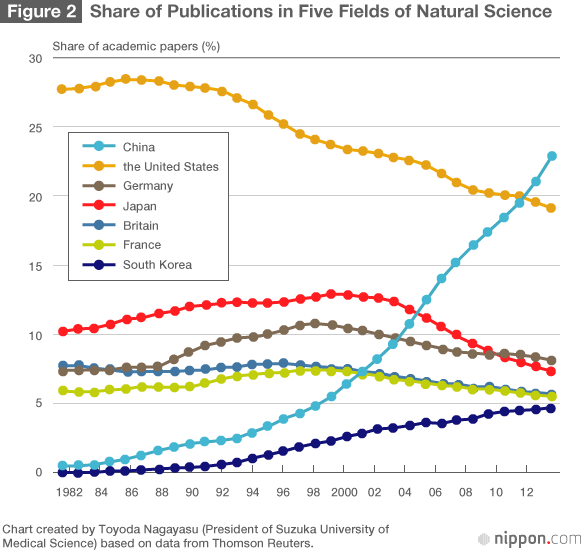
Japan Falling Behind in Scientific Publishing
Science Technology- English
- 日本語
- 简体字
- 繁體字
- Français
- Español
- العربية
- Русский
Nobel Prizes May Become Rarer for Japan
The Nobel Prize is the world’s most-esteemed award for scientific research. In 2015, Japan’s high level of research in natural science was attested to by the fact that two of its citizens were Nobel winners: Ōmura Satoshi (Nobel Prize in Physiology or Medicine) and Kajita Takaaki (Nobel Prize in Physics). In 2014 as well, three Japanese researchers were awarded the Nobel Prize in Physics. But even though Japanese scientists are regularly winning this prestigious award, the actual number of Japanese researchers who are publishing academic papers has declined in recent years.
If we look at the Japanese winners of the Nobel Prize in the natural sciences, most of their research dates back 10 to 30 years from the date they received the award, so many of the recent winners are gaining recognition for the results they began generating in the 1980s or 1990s. One cannot help wondering if Japanese scientists will be able to continue receiving the Nobel Prize at the same rate in the years ahead.
Overtaken by Germany and China, with South Korea Gaining Fast
The figures on the number of publications by Japanese researchers in the fields of natural science are available on the databases of Thomson Reuters and academic publisher Elsevier. Figures from Thomson Reuters show that since around the year 2000 the number of papers published by Japanese authors has stagnated. The data from Elsevier indicates that since 2004, when Japan introduced the national university corporation system, the number of papers has dropped noticeably.
Statistics from Thomson Reuters on publications in seven leading countries for five academic fields (physics, chemistry, biology, materials science, and space science) show that in 1982 the company had a total of 121,739 academic papers in its database, of which the United States accounted for 33,744, making it the leading country. Japan ranked second, with 12,534 papers published.
However, if we look at the figures in 2011, we see that Japan only ranked fourth, with 31,487 papers published. This places the country slightly behind third-place Germany, at 33,517, and far behind the two leading countries, the United States and China, which accounted, respectively, for 78,242 and 76,664. Meanwhile, South Korea has been quickly catching up to Japan.


The president of Suzuka University of Medical Science, Toyoda Nagayasu, argues that the decline in Japan’s ranking reflects the reduction in government funding for research as well as the increase in the amount of time university faculty must now spend on non-research activities such as administrative tasks.
Maskawa Toshihide, winner of the 2008 Nobel Prize in Physics, was quoted as saying that, “since nine or ten people win the Nobel Prize every year, it is natural to expect that at least one would be from Japan.” But the expectation expressed in that theory is based on the global share of publications that Japan has had. That is to say, up until around 2001, Japan was in the envious position of having a 10% to 13% share of the world’s academic papers, ranking second.
President Toyoda argues that in order to raise the number of academic papers in the fields of natural science, it is necessary to increase the number of full-time researcher posts. In a telephone interview with Nippon.com, he noted that the way things are going, “Japanese scientists will probably only account for one of every 20 Nobel Prize winners 10 years from now.”
Decrease in Government Funding
Ever since Japan’s national universities were reorganized as national university corporations to give them more autonomy, the administrative grants that the universities receive from Japan’s Ministry of Education, Culture, Sports, Science, and Technology have been cut by 1% annually. This has decreased the amount of research funding available and led to administrative staff reductions, which in turn places a greater burden on faculty. Some have pointed to the impact that this change has had on the output for academic papers.
Only a few of the top universities like the University of Tokyo or Kyoto University have ample research funds at their disposal. Most of the other national universities are forced to aggressively solicit outside funding from corporations and other organizations. This situation encourages research that focuses on highly practical, short-term results, in line with the demands of industry.
University of Tokyo Slips in Global Ranking
The 2015 World University Rankings published in the October issue of the Times Higher Education saw Japan’s leading institute of higher learning, the University of Tokyo, fall to third place in Asia, behind National University of Singapore and Peking University, after having been ranked the top Asian university in 2014.
The ranking is based on 13 criteria, including the number of citations of academic papers and the number of foreign faculty members. Education ministry officials said that Japanese universities were at a disadvantage in the ranking because it prioritized papers written in English.World University Rankings (Times Higher Education)
| 2014 | 2015 | ||
|---|---|---|---|
| 1 | California Institute of Technology (United States) | 1 | California Institute of Technology (United States) |
| 2 | Harvard University (United States) | 2 | University of Oxford (Britain) |
| 3 | University of Oxford (Britain) | 3 | Stanford University (United States) |
| 4 | Stanford University (United States) | 4 | University of Cambridge (Britain) |
| 5 | University of Cambridge (Britain) | 5 | Massachusetts Institute of Technology (United States) |
| 6 | Massachusetts Institute of Technology (United States) | 6 | Harvard University (United States) |
| 7 | Princeton University (United States) | 7 | Princeton University (United States) |
| 8 | University of California, Berkeley (United States) | 8 | Imperial College London (Britain) |
| 9 | Imperial College London (Britain) | 9 | Swiss Federal Institute of Technology in Zurich |
| 10 | Yale University (United States) | 10 | University of Chicago (United States) |
Asian Universities in the Ranking
| 2014 | 2015 | ||
|---|---|---|---|
| 23 | University of Tokyo (Japan) | 26 | National University of Singapore |
| 25 | National University of Singapore | 42 | Peking University (China) |
| 43 | University of Hong Kong | 43 | University of Tokyo (Japan) |
| 48 | Peking University (China) | 44 | University of Hong Kong |
| 49 | Tsinghua University (China) | 47 | Tsinghua University (China) |
| 50 | Seoul National University (South Korea) | 55 | Nanyang Technical University (Singapore) |
| 51 | Hong Kong University of Science and Technology | 59 | Hong Kong University of Science and Technology |
| 52 | Korea Advanced Institute of Science and Technology | 85 | Seoul National University (South Korea) |
| 59 | Kyoto University (Japan) | 88 | Kyoto University (Japan) |
| 61 | Nanyang Technical University (Singapore) | ||
| 66 | Pohang University of Science and Technology (South Korea) | ||
science national university corporation Nobel Prize Omura Satoshi Kajita Takaaki Natural science World University Ranking Maskawa Toshihide